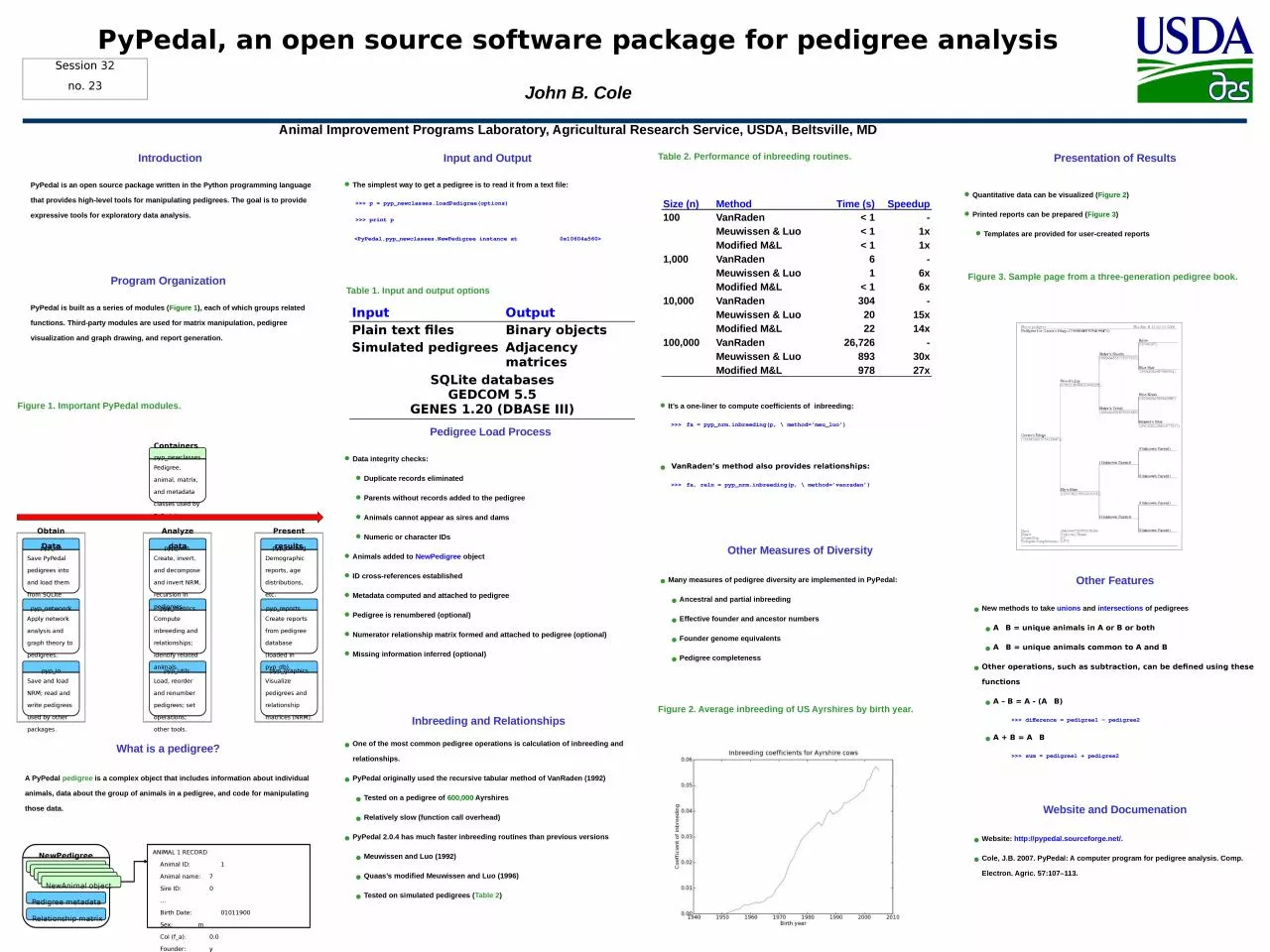

Program Organization Data integrity checks Duplicate records eliminated Parents without records added to the pedigree Animals cannot appear as sires and dams Numeric or character IDs ID: 934546
Download Presentation The PPT/PDF document "Introduction Pedigree Load Process" is the property of its rightful owner. Permission is granted to download and print the materials on this web site for personal, non-commercial use only, and to display it on your personal computer provided you do not modify the materials and that you retain all copyright notices contained in the materials. By downloading content from our website, you accept the terms of this agreement.
Slide1
Introduction
Pedigree Load Process
Program Organization
Data integrity checks:
Duplicate records eliminatedParents without records added to the pedigreeAnimals cannot appear as sires and damsNumeric or character IDsAnimals added to NewPedigree objectID cross-references establishedMetadata computed and attached to pedigreePedigree is renumbered (optional)Numerator relationship matrix formed and attached to pedigree (optional)Missing information inferred (optional)
Other Measures of Diversity
Presentation of Results
Quantitative data can be visualized (Figure 2)Printed reports can be prepared (Figure 3)Templates are provided for user-created reports
PyPedal is an open source package written in the Python programming language that provides high-level tools for manipulating pedigrees. The goal is to provide expressive tools for exploratory data analysis.
Many measures of pedigree diversity are implemented in PyPedal:Ancestral and partial inbreedingEffective founder and ancestor numbersFounder genome equivalentsPedigree completeness
One of the most common pedigree operations is calculation of inbreeding and relationships. PyPedal originally used the recursive tabular method of VanRaden (1992)Tested on a pedigree of 600,000 AyrshiresRelatively slow (function call overhead)PyPedal 2.0.4 has much faster inbreeding routines than previous versionsMeuwissen and Luo (1992)Quaas’s modified Meuwissen and Luo (1996)Tested on simulated pedigrees (Table 2)
Website and Documenation
Website: http://pypedal.sourceforge.net/.Cole, J.B. 2007. PyPedal: A computer program for pedigree analysis. Comp. Electron. Agric. 57:107–113.
PyPedal is built as a series of modules (Figure 1), each of which groups related functions. Third-party modules are used for matrix manipulation, pedigree visualization and graph drawing, and report generation.
pyp_newclasses
Pedigree, animal,
matrix, and metadata
classes used by
PyPedal
.
pyp_db
Save
PyPedal
pedigrees into
and load them from SQLite tables.
p
yp_graphics
Visualize pedigrees
and relationship
matrices (NRM
).
pyp_reports
Create reports from pedigree database (loaded in
pyp_db
).
pyp_io
Save and load
NRM; read and write
pedigrees
used
by other
packages.
pyp_utils
Load, reorder and renumber pedigrees;
set operations; other tools.
pyp_metrics
Compute inbreeding and relationships; identify related animals
.
pyp_netwoork
Apply
network analysis and graph theory to
pedigrees.
pyp_nrm
Create, invert, and decompose
and
invert NRM
,
recursion in pedigrees.
pyp_demog
Demographic reports
,
age distributions, etc.
Obtain Data
Present results
Analyze data
Containers
Figure 1.
Important
PyPedal
modules.
Input and Output
What is a pedigree?
A
PyPedal
pedigree
is a complex object that includes information about individual animals, data about the group of animals in a pedigree, and code for manipulating those data.
NewPedigree
Pedigree metadata
Relationship matrix
NewAnimal
object
ANIMAL 1 RECORD
Animal
ID:
1
Animal
name: 7
Sire
ID:
0
…
Birth
Date:
01011900
Sex
:
m
CoI
(f_a): 0.0 Founder: y …
The simplest way to get a pedigree is to read it from a text file:
>>> p = pyp_newclasses.loadPedigree(options) >>> print p <PyPedal.pyp_newclasses.NewPedigree instance at 0x10604a560>
InputOutputPlain text filesBinary objectsSimulated pedigreesAdjacency matricesSQLite databasesGEDCOM 5.5GENES 1.20 (DBASE III)
Inbreeding and Relationships
Table 2. Performance of inbreeding routines.
Size (n)MethodTime (s)Speedup100VanRaden< 1-Meuwissen & Luo< 11xModified M&L< 11x1,000VanRaden6-Meuwissen & Luo16xModified M&L< 16x10,000VanRaden304-Meuwissen & Luo2015xModified M&L2214x100,000VanRaden26,726-Meuwissen & Luo89330xModified M&L97827x
It’s a one-liner to compute coefficients of inbreeding: >>> fa = pyp_nrm.inbreeding(p, \ method='meu_luo') VanRaden’s method also provides relationships: >>> fa, reln = pyp_nrm.inbreeding(p, \ method=’vanraden’)
Figure 2. Average inbreeding of US Ayrshires by birth year.
Figure 3. Sample page from a three-generation pedigree book
.
Other Features
New methods to take
unions and intersections of pedigreesA B = unique animals in A or B or bothA B = unique animals common to A and BOther operations, such as subtraction, can be defined using these functionsA – B = A - (A B) >>> difference = pedigree1 – pedigree2A + B = A B >>> sum = pedigree1 + pedigree2
Table 1.
Input and output options